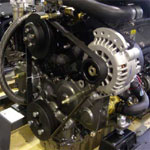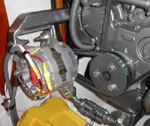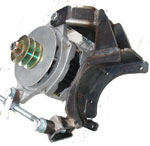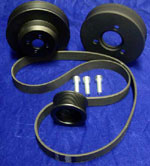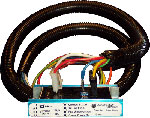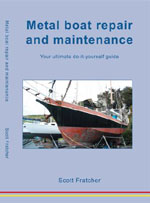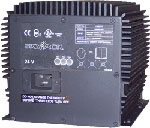Trouble shooting marine refrigeration and marine air
By: Scott
Fratcher - Marine Engineer/Captain
Contrary to popular belief, troubleshooting a boat’s refrigeration
can be tackled without gauges. Many system malfunctions can be solved
by DIYers using nothing more than a multimeter and a little forethought
An important first step. Forethought testing involves taking a series
of “normal” measurements from the boat’s refrigeration
system when everything is running correctly. It is this “base-line”
of tests we refer back to when attempting to solve a refrigeration issue.
All readings should be kept in the ship’s log.
Tools needed for tests:
* Stopwatch
* Temperature probe or laser temp gauge
* Multimeter
Before beginning the tests, take the temperature of the seawater, the
ambient air and inside the fridge box. Also note battery voltage and
amount of food in fridge box.
The base-line readings we’re looking for are:
1. The time required to cool the refrigerator box from start up
2. How long the compressor runs per cycle after the box has reached
target temperature
3. How long the compressor remains off between cycles
4. Length of time before all bubbles stop flowing through sight glass
5. The amount of cooling water flow being pumped
6. If possible, temperatures of all in/out points on the system including
the compressor, condenser, expansion valve and cold plate
7. Note any areas where water condensates or ice forms on the refrigeration
lines
8. Take voltages from the input of the fridge’s electrical junction
box and the compressor itself
Taking these measurements when the refrigeration system is working properly
is important – they provide a simple method of comparison when
something goes wrong.
It’s not cooling
Don’t delay – the sooner we start to record new observations
of the system, the quicker we’ll find the problem (and maybe prevent
burned up components). Let’s take a look at what each change of
parameter might mean.
Length of time to cool
Often the fridge is making all the normal noises but it’s taking
its time to cool down. Note, if you’ve just filled the box for
a boat trip, it will take a bit longer to cool down. But let’s
assume the cold box load is the same as usual. And let’s say that
where the fridge was originally running 15 minutes per hour to maintain
temperature, it now takes 30 minutes.
If you have a water-cooled system, the first thing to check is water
flow. Any restriction causes inefficiency, and it’s easy to check
and correct. It may need a back flush or rinse with muriatic acid (available
at Sailor’s Corner), a cleaning of the sea strainer or maybe it’s
a pump issue.
For an air-cooled system, check that the circulation fan is functioning
and whether the cooling fins have been bent, crushed or are full of
lint. If so, use a “fin comb” to straighten or clean the
fins (see picture above). Also check that there is a clear air-flow
around the fins. Any restriction will compromise performance.
Next, look at the sight glass. It’s a window into the inner workings
of the refrigerant. If you see a long string of bubbles, the system
may have a leak. This means finding the leak and a recharge (and usually
means calling in a technician).
Lastly, compare all the new temperature readings with the base-line
tests. Any significant difference will point to the troubled component.
For example, if the base-line test showed a 3oC rise in sea water temperature
through the condenser, and the new test only 1oC, this could mean a
clogged condenser, or an insulating residue such as oil building up
inside the condenser.
No noises
You don’t hear any clicks, nor the typical hum of the compressor
in operation. The first step is to check voltage at the fridge electrical
junction box. Compare this reading to the base-line reading.
If there is no voltage at the junction box, check the fuse or breaker.
If the breaker has blown this could mean the compressor is drawing too
much current.
Overload trips may also be caused by:
* The start relay not opening
* The breaker itself failing
* Poor feed wire condition
* Shorted motor winding
* A seized compressor
To check for a shorted winding, disconnect the compressor motor wires
completely from the electrical system. Be careful here if you have a
240-volt AC system – first disconnect the power source to eliminate
the possibility of electrical shock.
Check for continuity from the motor leads to the case. There should
be no continuity except for the green ground lead. Any reading on the
multi meter’s ohm scale means the motor windings are failing and
will need to be replaced.
Next, check for voltage at the compressor. If we have input voltage
but no compressor movement, look for indications the motor is trying
to “start” (for example, a jerking motor or loud hum).
No indication of a motor trying to start could be caused by:
* Open circuit electric motor IE burned winding
* An internal connection wire may be fatigued and cracked
* Worn out brushes
* A very dirty commutator
A loud hum may mean:
* A seized compressor
* A compressor that has hydro-locked
* A failed capacitor
* A failed start relay
* A stuck centrifugal disconnect switch
* A seized motor or compressor bearing
If a gentle "thunk" with the palm of your hand makes the
motor start, this indicates worn brushes or a dirty commutator.
If you have a belt-driven compressor, try giving the motor a little
start spin. If it begins to rotate, replace the start capacitor.
No compressor voltage
If there is no voltage at the compressor but there is voltage at the
junction box, we have a control system issue. This is typically a good
thing, as control systems are often less expensive to repair than a
compressor or other major system component.
The refrigeration control system is simply an on/off thermostat switch
that monitors temperature. To test it, find the leads from the thermostat
and briefly cross them. If the compressor jumps to life, you need a
new thermostat.
If the compressor doesn’t start after bridging the leads, try
pushing the relay or contactor closed. If the motor begins spinning,
test for voltage on the control side of the relay. If you have control
voltage but the relay is not closing, you need a new relay. If you don’t
have control voltage, it’s likely the circuit board has failed.
Sight glass bubbles
If the refrigeration system sounds normal (clicks, hums, and compressor
noises), but the cold box is not cooling, check the sight glass. Most
boat refrigeration systems have a sight glass for monitoring basic performance.
From initial start up, the sight glass should clear within a few minutes.
Note: no bubbles may mean all the refrigerant has leaked. If you suspect
this, stop the compressor immediately as the refrigerant is also a lubricant
in some systems. Running a “dry” system may cause damage.
If the sight glass shows continuous bubbles, you have lost refrigerant
and the system probably needs a recharge.
Expansion valve
Every cooling system needs to release the liquid refrigerant in a controlled
manner. This is the job of the TX valve. It’s normally trouble
free, but there are a few tests to check it.
With the system operating, find the TX valve and listen for hissing.
Hissing may mean low refrigerant.
If the system begins to cool but loses its ability to pull the temperature
down after a few minutes of running, the TX valve may be icing up. Turn
off the system and let the TX valve defrost for a few minutes. Turn
on the system again, and if it begins cooling only for a few minutes,
it’s likely the TX valve is icing up on the inside and blocking
the flow of refrigerant. This requires a pump down and a new moisture
filter.
Insulation
Insulation is the bottom line for maintaining efficiency in any refrigeration
system. The better it can hold the cold, the less the fridge is going
to work and the less energy the system consumes.
Common tricks to increase chilly box efficiency:
1. Make an insulating blanket that lays over the top counter or sides
of the fridge box. Some boaties even make a fridge blanket that hangs
over the side of the outer hull to add extra insulation and shade to
the side of the box against the hull.
2. Use a laser temp gauge to look for cold spots around the fridge.
Often most of the insulation is working well, but a small area needs
to be renewed. Any fridge area showing condensation is a sure bet large
amounts of energy are being lost.
3. Fill unused areas of the fridge or freezer with plastic bottles of
water. The water acts as a “battery” to help maintain temperature.
4. Pay particular attention to the door/hatch seals. Worn seals waste
power and cause air circulation inside the chilly box. Air circulation
causes condensation on the cooling plates. This condensation causes
ice to form, meaning fewer days between defrosting cycles. Condensation
can also cause water to soak into the insulation, causing excess corrosion
on the cooling lines meaning early failure.
While you may not be able to always fix the cooling system problem,
at least being able to identify the fault will allow the boat owner
to make a clear decision, thus saving time
and money.
Boat refrigeration systems
There are three basic styles:
- Belt- or electrically-driven compressor
- Small, portable, hermetically-sealed plug and play system
- Propane-heated plug and play system
Choosing a system that’s right for your boat is a matter
of personal choice. A quick look at the benefits and restrictions
of each system may help you decide.
Engine-driven
Belt driven systems are powerful, allowing quick temperature pull
downs. This is the system of choice for the DIY and those who want
to freeze the occasional large fish. The disadvantage is that they
are high maintenance and can mean running the engine every day.
Portable system
Small portable systems are simple to install. Just connect the
power cables and turn it on. The power drains for portable units
has dropped considerably in the last few years due to increased
design and insulation efficiency. The big disadvantage is the inability
to quickly pull down the temperature of large loads. This means
catching and preserving large fish can be a challenge.
Propane system
Propane systems have a devoted following due to easy installation,
completely silent operation, extremely low maintenance, 20+ year
life span and no need to upgrade the yacht’s electrical system.
The disadvantage is the need to carry extra propane and the ever-present
explosive nature of propane.
|

